

 |
 |
Bubwith |
* William the Conqueror ordered a survey of the whole kingdom A.D. 1083, to ascertain the value of the landed property, that he might tax it at discretion. This volume was put together at Winchester, and entitled "The Roll of Winchester ;" though from dislike to the measure it was called the "The Domesday Book."
† The frequent mention of the name of Tyson in documents of the date of the Conquest would lead us to the conclusion that they formed a family of importance, and we repeatedly meet with the name in connection with works of piety and devotion. Thus a person of the name was founder of the Abbey of Bridlington, as the following document shows : "Iste Gisbrighton Tison fuit Dominus de Bridlington, Walton, Melton, et Alnewike: Et ut a quibusdam Scriptis invenitur fuit fnndator Abbathiarum de Bridlington, de Walton, de Malton, de Alnewike. Sed verius mihi videtur, et arbitror, quod successores ejus fundaverunt proedicta monasteria pro anima ejus dictus est eorumfundator, non ejus facto sed successorum devotione ut imferius manifestabitur. Iste autem Gisbrightus genuit Wm. Tyson et Ricardum Tison. Wm. Tison, corruit in bello contra Haraldum Angliae invasorem." Richard Tyson was founder of Gisborough Priory.
| £. | s. | d. | |
| Bubwythe Medietas vicarie valor per annum | vij. | ij. | iiij. |
| Decima inde | xiiij. | iij. | |
| Bubwyth altare medietas vicarie valet clare per ann | viij. | - | iiij. |
| Decima inde | xvj. |
* This work we desire cordially to recommend to all persons interested in the history of the Church in the diocese of York and Ripon.
| Bubwith | 519 |
| Brighton and Gunby | 210 |
| Foggathorpe | 96 |
| Gribthorpe | 61 |
| Willitoft | 53 |
| Harlthorpe | 100 |
| Spaldington | 313 |
| Total | 1352 |
* Bubwith is 6 miles N. by W. from Howden.
| Temp. Instit. | Rectores. | Patronii. | Vac per |
| 3 Ida Ap. 1282 | Jac de Moun. | Dno Agnes de Vesey | |
| 16 Kal Mar. 1287 Jno. Bassel. | |||
| 6 Kal Ap. 1310 Adam de Osgoteby. | |||
| 6 Kal Oct. 1310 Richard de Osgodby. | |||
| 2 Kal Feb. 1316 Rich. de Osgotby. | |||
| Kal Oct. 1322. | Thomas de Sunnebrey. | ||
| 7 Ids Nov. 1322 Rich. de Bretteby. | |||
| 6 Aug. 1328 | Nich. de Welleburn. | ||
| 7 Feb 1340 | Jno. Noble. | ||
| 3 July 1364 | Wm. de Wyrkesworthe. | ||
| 27 Mar. 1367 | Wm. ill Alex. de Skamerton. | ||
| Temp. Instit. | Vicars. | Patron. | Vac per |
| Robt. Thormotby. | |||
| 7 Mar. 1422 | Rich. Marton. | ||
| Ult. Maij. 1440 | William Croft. | ||
| 15 Nov. 1466 | Rich. Appleton. | ||
| 26 Oct. 1486 | Robt. Holtby. | ||
| 17 Oct. 1506 | Thomas Taillour. | ||
| 13 Maij 1515 | Jno. Browne. | ||
| 15 Mar. 1517 | Tho. Jefferson. | ||
| 1520 | Jno. Shacklock. | ||
| 4 Nov. 1521 | Thomas Dixon. | ||
| 7 Sept. 1537 | Thomas Caldbeck. | ||
| 9 Sept. 1573 | Robt. Maynard, clk. | ||
| 21 June 1586 | William Purret. | ||
| 22 June 1620 | Jno. Bayles. | ||
| Jan. 1343 | dno John Staynegate. | Dec. & cap. Ebor. | |
| Maij 1358 | dno Hen. de Birkenscagh. | ||
| 4 July 1359 | dno Adam de Esington. | ||
| Feb. 1364 | dno Steven de Bubwith. | ||
| 8 Feb. 1365 | dno Adam de Laxton. | ||
| 8 Mar. 1374 | dno Wm. Paulyne. | ||
| dno Wm. Burton. | Resig. | ||
| Nov. 1398 | dno Tho. Hesyle. | ||
| Mar. 1390 | dno Jno. Wall. | ||
| 1 Aug. 1391 | dno Robt. fil Ric de Hemyngburgh. | ||
| 12 Mar. 1408 | dno John Langetoft. | ||
| dno Wm. Rikall. | |||
| dno Wm. Walton. | |||
| 19 Feb. 1437 | dno Robert Broune. | ||
| 1 Oct. 1442 | dno Jno. Spencer. | ||
| 3 Jan. 1452 | dno Jon. Walker. | ||
| 7 Feb. 1487 | dno Wm. Kexby | ||
| 24 Sept. 1499 | dno Rich. Savage. | ||
| 26 Aug. 1526 | dno Rich. Hawclyffe. | ||
| 4 Junij 1558 | dno Jno. Clowdersdale. | ||
| 7 July 1573 | dno Wm. Parret, clk. | ||
| 28 Nov. 1586 | dno Jno. Lambe. | ||
| 20 Maij 1617 | dno Wm. Squire. | ||
| 10 Mar. 1646 | dno Robt. Brooke. | ||
| 23 Mar. 1660 | dno Rowland Greenwood. | ||
| 2 July 1663 | dno J. Dyson. | ||
| 22 Mar. 1665 | dno Rich. Basset. | ||
| 19 Maij 1688 | dno Guili. Calvert. |
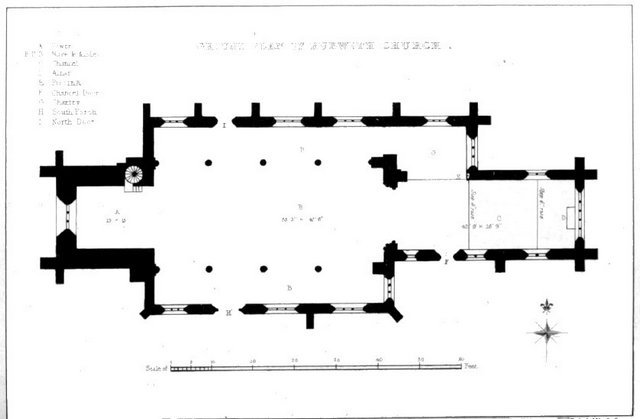
* ANCIENT FORM OF DEDICATION.-" The following particulars are extracted and condensed from Martene's invaluable work : and as his account is not easily accessible, and somewhat long, it has been thought well to subjoin them here.
Churches were often, in the primitive ages, dedicated by more than one Bishop. Constantine having completed a magnificent church at Jerusalem, invited the Prelates, then assembled in Council at Tyre, to assist in its consecration. -Euseb. Vit. Const. iv, 43. SOZOMEN. 1, 40.
Constantius his son, having finished a church erected by his father at Antioch, Eusebius of Nicomedia, the intruding Patriarch of Constantinople, summoned a Council under pretence of consecrating the church, however much in reality to decide against the Catholick Doctrine of Consubstantiality. Ninety-seven Bishops were present.-SOZOMEN. iii, 5.
So it was also in the western Church. This is proved by the Preface to the 4th Council of Arles, holden in 524: which begins, When the Priests of the Loan had assembled in the Will of GOD to the Dedication of the church of S. Mary at Arles.
In the time of S. Louis, Pope Pascal I. consecrated the church of S. Vincent, with the Sacred College of Bishops and Cardinals. About the year 1015, the Crypt of the monastery of S. Michael was consecrated by S. Bernard of Hildersheilm, and two other Bishops; and three years afterwards, the church being finished, it was consecrated by the same S. Bernard with three other Bishops. Viti. S. Bernardi. cap. xxxix, xl.
All these Bishops took an actual part in the service. In the consecration of the church of Mans, in 1120, the High Altar was consecrated by Gilbert, Archbishop of Mans : S. Julians by Galfred of Rouen : Hildebert of Mans, consecrated S. Mary's; Reginald of Angiers, that of the Holy Cross. There is a fine passage to the same point in Sugerius's book on the Dedication of the church of S. Denis : "Right early in the morning," saith he, "Archbishops and Bishops, Archdeacons and Abbats, and other venerable persons, who had lived of their proper expense, bore themselves right bishopfully; and took their places on the platform raised for the consecration of the water, and placed between the sepulchres of the Holy Martyrs and S. Saviour's Altar. Then might ye have seen, and they who stood by saw, and that with great devotion, such a band of so venerable Bishops, arrayed in their white robes, sparkling in their pontifical robes and precious orfreys, grasp their Pastoral Staves, call on God in Holy Exorcism, pace around the consecrated enclosure, and perform the Nuptials of the Great King with such care, that it seemed as though the ceremony were performed by a chorus of angels, not a band of men. The crowd, in overwhelming magnitude, rolled around to the door : and while the aforesaid Episcopal band were sprinkling the walls with hyssop, the King and his nobles drive them back, repress them, guard the portals."
Yet the principal actor on the occasion was the Bishop of the Diocese. The thirty-sixth Canon of the second Council of Arles decrees, If a Bishop be minded to build a church in another Diocese, let its dedication be reserved for the Diocesan. S. Columbanus, being only a Priest, dedicated the church of S. Aurelia. Walfrid. Strabo. Vita. S. Gallo, cap. vi.
The preceding night was spent either in the church, or in neighbouring churches in a solemn Vigil. S. Ambrose testifies that this was done on occasions of the Dedication of the Ambrosian church. Epist. 22, ad Marcellina. So S. Gregory of Mans, in his Dedication of the church of S. Julian, removed the relics of that Saint into the church of S. Martin, and there kept Vigil. De Glor. Mart. ii. 34.
Relics were considered indispensably necessary : so S. Paulinus (Epist. xxxii, ad Sever.) This church was dedicated in the name of CHRIST, the SAINT of Saints, the MARTYR of Martyrs, the LORD of Lords, and was honoured with the relics of the Blessed Apostles. See also the beautiful epistle of S. Ambrose, translated in the church of the Fathers. The phrase was,Consecrare ecelesiam de reliquiis Beati n.
Yet some churches were consecrated without relics. The second Nicene Council, decreed that in this case they should be supplied. Those portions of the Consecrated Elements were placed with these : to which perhaps that expression of S. Chrysostom is to be referred -What is the Altar by Nature but a stone ? But it is made holy, when it bath once received the Body of Christ.
These relics occupied different positions. In the Church of S. Benedict, consecrated by Pope Alexander II., there were relics in the Chapel-apse of S. John, in the bases of the Piers, in the four angles of the bell tower, in the cross on the western gable, in the cross of the tower. Chron. Cass. iii, 30.
Ashes were sprinkled on the floor, and the Bishop with his Pastoral Staff wrote on them the Alphabet, sometimes in Latin alone, sometimes in Greek also.
The whole ceremony concluded with the endowment of the church: or, as it was termed, presenting its dowry."-From " Durandus on the Symbolism of Churches and Church Ornaments, edited by the Rev. J. M. Neale and the Rev. B. Webb, (Rivingtons, London). A work which we cannot too highly recommend to all who take an interest in Ecclesiastical Architecture and Antiquities.
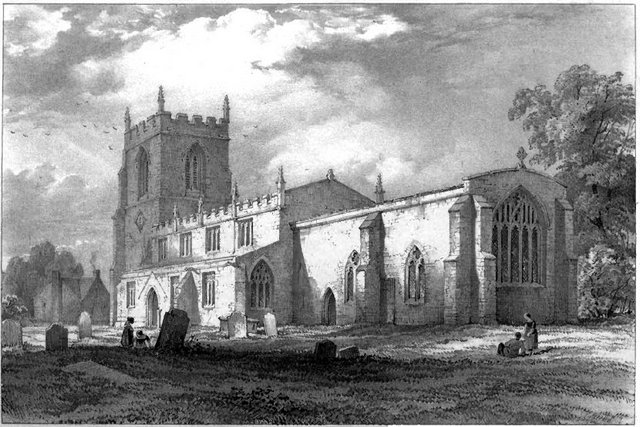 The Nave is lighted by four clerestory windows on either side, square headed, consisting of three lights each, cinque-foiled, without labels. The parapets of the Nave are embattled, and from them spring crocketed pinnacles -the faces of the pinnacles on the South side have shields with the following armorial bearings :- On a chief two mullets ; barry of four ; a fess
lozengy; quarterly, over all a bend. On the West buttress is a shield of arms, on a bend, three cinquefoils. There are no shields on the North side.
The Nave is lighted by four clerestory windows on either side, square headed, consisting of three lights each, cinque-foiled, without labels. The parapets of the Nave are embattled, and from them spring crocketed pinnacles -the faces of the pinnacles on the South side have shields with the following armorial bearings :- On a chief two mullets ; barry of four ; a fess
lozengy; quarterly, over all a bend. On the West buttress is a shield of arms, on a bend, three cinquefoils. There are no shields on the North side.
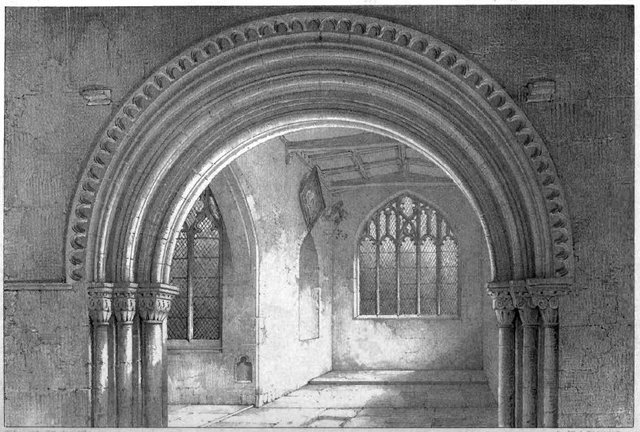 The proportions of the Chancel are extremely good, but the general effect is much injured by the modern screen work which divides it into two equal parts. The lower portion of the wall within the screen is covered with wood panelling in the style of Carpenter's Gothic, the removal of which would add much to the beauty of the whole. The date of this work is A.D. 1781.
On the South side, the Chancel is entered by a low Priests' door, the height of which has evidently been contracted by the surface of the external ground being raised, so as to make the floor of the Chancel lower than that of the adjacent Churchyard. The North window has been blocked by the erection of a School-house as also the East window of the North Chantry. The
removal of such School, and the restoration of these windows is a work earnestly to be desired. The roof is of good oaken panelling; the principal beams resting upon plain corbels, and the cornice embattled. On the walls are some helmets and mantlings, belonging to the Vavasours of Melbourn.
The proportions of the Chancel are extremely good, but the general effect is much injured by the modern screen work which divides it into two equal parts. The lower portion of the wall within the screen is covered with wood panelling in the style of Carpenter's Gothic, the removal of which would add much to the beauty of the whole. The date of this work is A.D. 1781.
On the South side, the Chancel is entered by a low Priests' door, the height of which has evidently been contracted by the surface of the external ground being raised, so as to make the floor of the Chancel lower than that of the adjacent Churchyard. The North window has been blocked by the erection of a School-house as also the East window of the North Chantry. The
removal of such School, and the restoration of these windows is a work earnestly to be desired. The roof is of good oaken panelling; the principal beams resting upon plain corbels, and the cornice embattled. On the walls are some helmets and mantlings, belonging to the Vavasours of Melbourn.
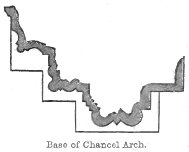 The most interesting feature in this Church is its Chancel Arch, which is Norman work. It consists of three concentric receding semicircular arches resting on as many shafts, with enriched capitals. The two outer pairs standing in the angles of square edged jambs, the last attached to the inner surface of the arch. The capitals are of different designs, but in each
case the under side of the abacus is enriched with the pellet moulding. The arch is composed of a series of roll-mouldings, and is finished with an arcade.
The most interesting feature in this Church is its Chancel Arch, which is Norman work. It consists of three concentric receding semicircular arches resting on as many shafts, with enriched capitals. The two outer pairs standing in the angles of square edged jambs, the last attached to the inner surface of the arch. The capitals are of different designs, but in each
case the under side of the abacus is enriched with the pellet moulding. The arch is composed of a series of roll-mouldings, and is finished with an arcade.
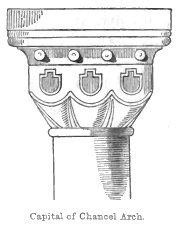 The beauty of this portion of the Church has been, until lately much concealed from view, by the pulpit and reading pew being placed under it, and some of the ornamental work on the South side had been cut away in order to make room for the former. We are happy to find that these eye-sores are now removed, and placed at the North West corner of the Chancel Arch, thereby
opening out the whole length of the Church, and permitting the minister to be seen and heard when officiating at the Communion Table.
The beauty of this portion of the Church has been, until lately much concealed from view, by the pulpit and reading pew being placed under it, and some of the ornamental work on the South side had been cut away in order to make room for the former. We are happy to find that these eye-sores are now removed, and placed at the North West corner of the Chancel Arch, thereby
opening out the whole length of the Church, and permitting the minister to be seen and heard when officiating at the Communion Table.
| Tower, | 16ft. by 16ft. |
| Nave, | 57ft. loin. by 25ft. 6in. |
| North and South Aisles of Nave, each | 57ft. 10in. by 8ft. 2in. |
| Chancel, | 44ft. by 16ft. 3in. |
| North Chantry, | 17ft. by 11ft. |
| Total length of Church, | 101ft. 10in. |
| Total breadth, | 41ft. 10in. |
| These are all interior admeasurements. | |